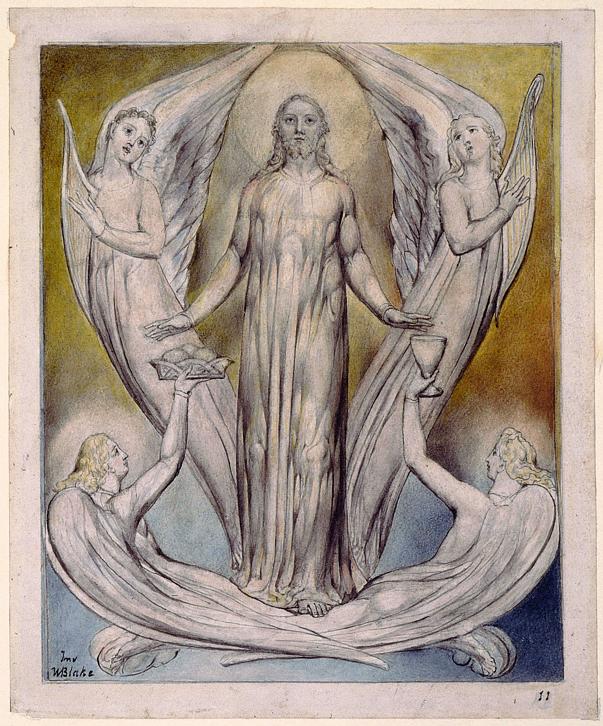Vision of Last Judgment, (E 562)
"Over the Head of the Saviour & Redeemer The Holy
Spirit like a Dove is surrounded by a blue Heaven in which are
the two Cherubim that bowd over the Ark for here the temple is
opend in Heaven & the Ark of the Covenant is as a Dove of Peace
The Curtains are drawn apart Christ having rent the Veil The
Candlestick & the Table of Shew bread appear on Each side a
Glorification of Angels with Harps surround the Dove
The Temple stands on the Mount of God from it flows on each
side the River of Life on whose banks Grows the tree of Life
among whose branches temples & Pinnacles tents & pavilions"
In the following lines Blake tells something of the process of
reaching Fourfold Vision through which he integrated into one
picture all the spiritual events of history. To perceive 'face to
face' and not 'through a glass darkly', one must 'give up Love':
that is dualistic thinking which is represented by sexual divisions.
Further one must 'root up the infernal grove', the dark, confused
logic derived from denying the reality of the Eternal, Infinite
world of the Spirit. Then shall man live in the state of mutual
forgiveness which delights and sustains mankind.  |
| Wikimedia Commons Illustrations to Milton's Paradise Regained Image 11 |
"Now I a fourfold vision see
And a fourfold vision is given to me
Tis fourfold in my supreme delight"
Songs and Ballads, My Spectre, (E 477)
"Let us agree to give up Love
And root up the infernal grove
Then shall we return & see
The worlds of happy Eternity &
Throughout all Eternity
I forgive you you forgive me
As our dear Redeemer said
This the Wine & this the Bread"
John Masefield caught some of the same ability to bring together varied images of spiritual development in his hymn written in 1911.
O Christ, who holds the open gate,
O Christ who drives the furrow straight,
O Christ, the plow, O Christ, the laughter
of holy white birds flying after.
Lo, all my heart's field red and torn,
and thou wilt bring the young green corn,
the young green corn divinely springing,
the young green corn for ever singing.
And when the field is fresh and fair
thy blessèd feet shall glitter there,
and we will walk the weeded field,
and tell the golden harvest's yield.
The corn that makes the holy bread
by which the soul of man is fed,
the holy bread, the food unpriced,
thy everlasting mercy, O Christ.
No comments:
Post a Comment